#Crop disease prevention
Explore tagged Tumblr posts
Text
Understanding the importance of crop Insurance | Kshema General Insurance
Farming in India is not just an occupation; it is a way of life for millions of small and marginal farmers. However, the unpredictable nature of agriculture—driven by erratic weather and market fluctuations — makes it one of the riskiest livelihoods. For a small farmer, a single failed crop can lead to catastrophic financial consequences, trapping them in a cycle of debt and poverty.
This is where crop insurance becomes a game-changer. Despite its affordability, many farmers fail to understand the importance of crop insurance.
Why Farmers Avoid Crop Insurance
Despite its numerous benefits, many farmers in India fail to understand the Importance of Crop Insurance and remain uninsured. The reasons include:
Lack of Awareness: Many farmers are unaware of crop insurance schemes or how they work.
Perceived Cost: Farmers assume that the insurance premiums are expensive, without realising how affordable they can be.
Complex Processes: Farmers often feel intimidated by the documentation and procedures involved in insurance enrollment.
These misconceptions prevent farmers from taking advantage of a safety net that can save them from financial ruin.
Kshema Sukriti Crop Insurance: Affordable Protection
At Kshema General Insurance, we understand the importance of crop insurance and the challenges faced by small and marginal farmers. Our Sukriti Crop Insurance policy is specifically designed to offer comprehensive protection at an affordable cost.
Key Features of Kshema Sukriti:
Affordable Premium: Starting at just Rs 499, it is one of the most affordable crop insurance options available to the farmers in more than 20 states and union territories in India.
Wide Coverage: Mitigates loss of crops due to natural disasters and animal attacks (elephants, wild boars, monkeys, and rabbits).
Easy Enrollment: Hassle-free, mobile app-based processes to make crop insurance accessible to all farmers.
Timely Compensation: Quick claim settlements to help farmers recover and restart their operations.
Customisation: Choice of 2 perils among a list of 8 predefined perils so that the farmers pay for only what they perceive as a danger to their crops.
By enrolling in Kshema Sukriti, farmers can avoid the crippling financial burden of crop failures and secure their livelihoods.
Read More: https://kshema.co/understanding-the-importance-of-crop-insurance/
#crop insurance#crop insurance in india#agri insurance#Agricultural Income Protection#Agricultural Risk Mitigation#Agricultural Risk Reduction#agriculture insurance#animal attack#climate change#Crop disease prevention#Crop Protection#damage due to aircraft#earthquake#Financial Security for Farmers#financial stability for farmers#fire#fire due to lightning#flood#hailstorm#Insurance Coverage for Farmers#kshema#kshema agriculture insurance#kshema crop insurance#Kshema general insurance#kshema sukriti#landslide#Plant disease management#Protection Against Natural Disasters#Sukriti#crop insurance in hyderabad
0 notes
Text
Understanding the importance of crop Insurance | Kshema General Insurance
Farming in India is not just an occupation; it is a way of life for millions of small and marginal farmers. However, the unpredictable nature of agriculture—driven by erratic weather and market fluctuations — makes it one of the riskiest livelihoods. For a small farmer, a single failed crop can lead to catastrophic financial consequences, trapping them in a cycle of debt and poverty.
This is where crop insurance becomes a game-changer. Despite its affordability, many farmers fail to understand the importance of crop insurance.
Why Farmers Avoid Crop Insurance
Despite its numerous benefits, many farmers in India fail to understand the Importance of Crop Insurance and remain uninsured. The reasons include:
Lack of Awareness: Many farmers are unaware of crop insurance schemes or how they work.
Perceived Cost: Farmers assume that the insurance premiums are expensive, without realising how affordable they can be.
Complex Processes: Farmers often feel intimidated by the documentation and procedures involved in insurance enrollment.
These misconceptions prevent farmers from taking advantage of a safety net that can save them from financial ruin.
Kshema Sukriti Crop Insurance: Affordable Protection
At Kshema General Insurance, we understand the importance of crop insurance and the challenges faced by small and marginal farmers. Our Sukriti Crop Insurance policy is specifically designed to offer comprehensive protection at an affordable cost.
Key Features of Kshema Sukriti:
Affordable Premium: Starting at just Rs 499, it is one of the most affordable crop insurance options available to the farmers in more than 20 states and union territories in India.
Wide Coverage: Mitigates loss of crops due to natural disasters and animal attacks (elephants, wild boars, monkeys, and rabbits).
Easy Enrollment: Hassle-free, mobile app-based processes to make crop insurance accessible to all farmers.
Timely Compensation: Quick claim settlements to help farmers recover and restart their operations.
Customisation: Choice of 2 perils among a list of 8 predefined perils so that the farmers pay for only what they perceive as a danger to their crops.
By enrolling in Kshema Sukriti, farmers can avoid the crippling financial burden of crop failures and secure their livelihoods.
Read More: https://kshema.co/understanding-the-importance-of-crop-insurance/
#agri insurance#agricultural risk mitigation#agriculture insurance#crop insurance#crop protection#crop disease prevention#climate change#agricultural risk reduction#animal attack#agricultural income protection#kshema#kshema general insurance#Crop insurance in india#crop coverage solutions
0 notes
Text
A Comprehensive Farming Guide on Tomato Fertilization
Tomato farming in Kenya is one of the most profitable agricultural crops due to the growing demand for tomatoes in both local and international markets. With the country’s population expanding, the consumption of tomatoes, a staple in Kenyan dishes, has increased, making it a viable option for many farmers looking to diversify their farming activities. Kenya’s climate is suitable for tomato…
#agricultural best practices for tomatoes#best fertilizers for tomatoes#biological pest control for tomatoes#blossom-end rot in tomatoes#calcium nitrate for tomatoes#drip irrigation for tomatoes#early blight in tomatoes#fertilization for high tomato yield#Kenya tomato farming tips#late blight in tomatoes#mulching in tomato farming#organic fertilizers for tomatoes#potassium nitrate for tomatoes#soil health for tomatoes#sustainable tomato farming practices#tomato crop rotation#tomato disease prevention#tomato farming in kenya#tomato fertilization guide#tomato fertilization schedule#tomato growth stages#tomato hornworm control#tomato irrigation practices#tomato pest management#tomato pests and diseases#tomato planting tips#tomato post-harvest handling#tomato pruning techniques#tomato variety selection#tomato yield improvement
0 notes
Text
Yellow Rust, Wheat Disease : कांगड़ा में पीला रतुआ से गेहूं फसल को बचाने के लिए कृषि विभाग ने क्या कदम उठाए?
कांगड़ा जिले के किसानों के लिए एक खतरनाक खतरा उत्पन्न हो गया है। पीला रतुआ, गेहूं की फसल को बर्बाद करने वाला एक खतरनाक रोग, ने किसानों की चिंता बढ़ा दी है। लेकिन कृषि विभाग इस संकट से निपटने के लिए पूरी ताकत से जुटा हुआ है। कृषि विकास खंड परागपुर में कृषि विभाग की टीम ने गेहूं की फसल का निरीक्षण किया और किसानों को इस खतरनाक रोग से बचने के लिए जागरूक किया। कृषि अधिकारियों ने इस रोग के लक्षणों को…
#Agricultural Disease Prevention Tips#Agricultural Officer Tips Kangra#Agricultural Tips#agriculture department#Agriculture Department Kangra#Bio Control for Wheat Disease#Bio Control for Wheat Rust#Bio Control Lab Palampur#How to Prevent Yellow Rust#Kangra Agriculture News#Kangra Agriculture News January 2025#Kangra Agriculture Update 2025#Kangra Farmers Wheat Disease Awareness#Kangra Wheat#Kangra Wheat Crop#Kangra Wheat Crop Damage#Kangra Wheat Disease Alert#Preventing Wheat Rust Disease#Symptoms of Yellow Rust in Wheat#Wheat Crop Protection Kangra#Wheat Disease#Wheat Disease Awareness#Wheat farming tips for farmers#Wheat Rust Control#Wheat Rust Control Methods#Yellow Rust#Yellow Rust Disease in Wheat#Yellow Rust Disease Wheat Control#Yellow Rust Symptoms#Yellow Rust Symptoms and Treatment
0 notes
Note
This isnt directed at anything specific, just want to do my best to help out the many people fleeing countries to seek aid in thailand as someone who both grew up here/speaks the language Id like to provide some specific experiences that help foreigners adjust.
First its extremely likely if someone moves to the south east that has been living in the northern hemisphere you will struggle most with the heat and humidity. White People Especially. All of you need to be drinking extra water everyday, this is not a joke heat stroke is very common for white people here because they dont realize how dehydrated they are until its already causing harm. Please stay safe.
If the summers start getting too hot take day trips to mountain towns/businesses there's a lot of local industry around people going to cooler weather at higher elevations during the hottest times of year.
Addition for health, Please get vaccinated Before coming here. We all trust all foreigners/tourists do (and since covid screenings in airports are much more common) Especially for mosquito transmissible diseases.
Thailand uses yearly field burning for crop rotation, this causes periods of the year with extreme air pollution/smog. cities will put out air warnings in advance so people can either seal their homes to prevent air from getting in unfiltered or wear smoke masks. I recommend people do this asap before its a necessity.
Language wise thailand has a large enough tourism base that most people also learn at least some english/there's businesses that teach foreigners thai. Learning before traveling is appreciated, the main thing to keep in mind is that since thai is a tonal language without tone control words can get mixed up/confused. (this is pretty normal for new speakers tho)
If people want to learn thai i highly recommend watching news broadcasts! you get to see a wide variety of speakers and use in conversations. Searching "ข่าว PP" or "ข่าว TNN" on youtube will get you fairly official political broadcasts, but even if you just search ข่าว or ข่าวดึก can bring up a lot of good examples of people speaking.
If youre an english speaker one of the best jobs you can look for is as an english teacher or tutor. It's a very searched for job and usually provides good opportunity for learning the language as well.
If youre in a big city look up the local train routes and use those, as finding parking/driving places will generally be much worse than just using the trains. That being said getting a motor bike is fairly easy and inexpensive for commutes if needed.
This is a disappointing but necessary heads up for foreigners, colorism is still a fairly wide spread issue in thailand. People arent violent but things like finding work/some aid does have discriminatory practices still and its extremely disappointing. There are local movements and people fighting to end it, but its been ingrained in a lot of people.
speaking of local communities if anyone who's coming to thailand is coming for hrt/trans support i highly recommend getting into contact with the local trans fem communities/gay centers. There's massive international culture and groups of people that will help you both get what you need and with support.
I know i said a lot here but i am genuinely really happy my home can provide safety and aid to people in hard times. I know from a lot of personal experience how scary it is when you have to flee your home, and if there's anything i can do to help ease that process even with limited resources i will do my best.
stay safe everyone and keep going.
noted. thank you so much. this is all incredibly helpful info, and it is obvious in how you delivered it that you sincerely care. i appreciate that a lot.
posting for anyone else eyeing Thailand.
273 notes
·
View notes
Text
The last video of the plant month serie! Exactly one week late but oh well 😅
We're two sisters collaborating on this video serie
@cybermanolol is in charge of the art and the editing 🎨 📽️ and @_chalulu_ is the one doing all the plant research and she's also the voice 📝🗣️
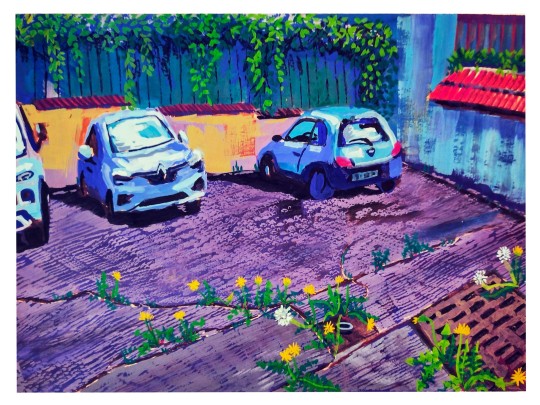
@_chalulu_ my sources are:
- Le régal végétal by François Couplan
- Cueillette buissonnière dans le bocage, usage populaire des plantes sauvages en Thiérache - Pays de Chimay. Edition 2020.
@cybermanoloart I've seen lots of paintings of dandelions, so I searched for a way to make one that was truly mine and original. @_chalulu_ is a little disappointed that it doesn't feature the plant more predominantly, but I wanted to showcase the dandelion's ability to grow into the most hostile of environments. What do you think about it? Agree with my sister, or do you like this Idea?
Choose your harvesting location well:
Do not enter private property and never harvest in a protected area. Also avoid roadsides or polluted sites.
Be sure to correctly identify everything you pick so as not to damage a rare species or poison yourself.
When in doubt, abstain or call someone with the relevant competence.
Harvest plants sparingly, only where they are abundant and never collect too much.
Take only as needed and do not pull out the entire crops.
Wash before eating.
Carefully sort and wash the crop. Be careful, only cooking can prevent certain diseases or parasites such as echinococcosis or liver fluke.
#art#my art#gouache#dandelion#pleinairpril#art process#artoftheday#nature#illustration#drawing#らくがき#イラスト#traditional illustration#traditional painting#traditional drawing#traditional art#video#gouache painting#plein air#pissenlit#parking
290 notes
·
View notes
Note
Despite Genya looking like his other siblings, I did always like how he had the same eyes as Sanemi showing that him and Sanemi do look the same despite Hiroshi looking like an exact copy of Genya just with different eyes. I always thought it was interesting because it made me wonder if Hiroshi looked up to Genya or if his hair grew out like Genya’s
YES!!! SAME! any connection Genya has with Sanemi I EAT UP they are such BROTHERS!!!! I think it's also implied they have the same face shape too!
Now, you may be thinking: "Maple, it's an anime, of course they have the same face shape" but hear me out!!
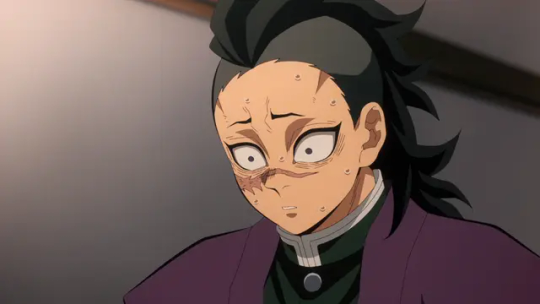
One thing I always notice with Genya is his forehead: specifically, those little creases on either side of his forehead! As far as I can see, he's the only one who has these little creases.
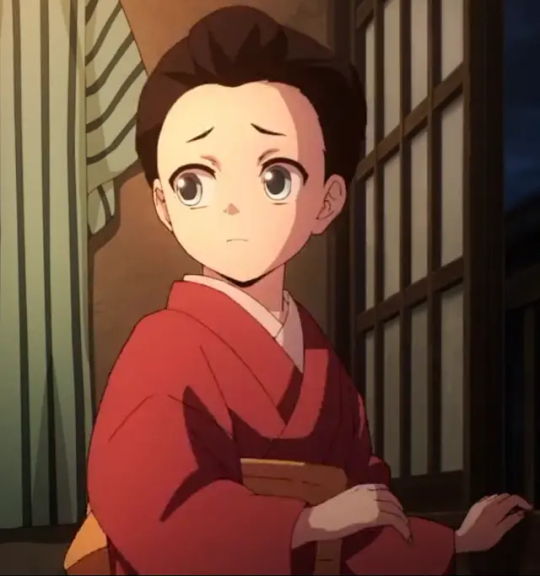




None of his other siblings have them!! All except for...


THAT'S RIGHT!!! SANEMI!!! Granted they're only visible in flashbacks but follow my delusions here!!
I choose to believe that this supports my headcanon that Sanemi and Genya actually look very similar, except for a difference in hair and build.


They've got similar little battle smiles, too<3 (even down to the cupid's bow) They've both got thick lashes as well (though Sanemi's got him beat there!)
As for Hiroshi! This is where I insert a few more of my headcanons!
For example: why does Genya shave the sides of his head? While I understand why they chose this detail from a design standpoint, I'm talking about in canon reasons. AND I actually adopted this headcanon from a tumblr post: this one! The headcanon being that Genya has curly hair and that's why he shaves it off<3
As for what they're saying about the databook, I have searched high and low, through every version of the databook I can find, and have yet to find this tidbit to be confirmed canon. HOWEVER, I adore it so much that it's canon in my heart!! We deserve curly-haired characters, and Genya would be SO CUTE with little ringlets as a baby!! As far as I can tell, that Tumblr post is the oldest source on it, as it was posted in 2019, while the other posts I've seen on it were from about a year ago.
As for the boys all having close-cropped hair (except for Sanemi) this may just be to keep their hair from getting matted and to prevent disease, something poorer families used to do. (there's also the wives' tale that shaving a baby's head will cause hair to grow back thicker and fuller) It was common to shave babies' heads until they reached three years old. Though Hiroshi and Genya definitely look to be older than three, it was probably just easier to keep their heads shaved than to have to deal with hair maintenance. BUT, keeping that one little bit of hair definitely feels deliberate and Hiroshi could definitely be trying to imitate his big brother Genya!!
Hehe I will definitely be thinking of little baby Hiroshi waddling along behind Genya wherever he goes.
Thank you so much for the ask!!
#demon slayer#kimetsu no yaiba#ramblies#genya shinazugawa#kny genya#shinazugawa brothers#kny sanemi#sanemi shinazugawa#anon ask#anonymous#I know i said I was gonna start with the afterlife scene but#I actually want to look at my asks first since you all have been sending so many!! <3 I can't leave yall hanging!
35 notes
·
View notes
Text
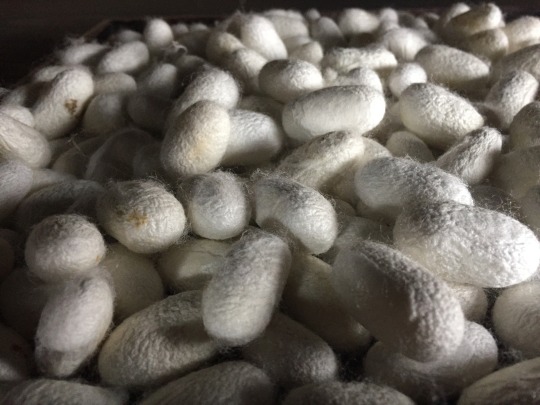
noteからの翻訳です。日本語の方はぜひ末尾のリンクから向こうへ。
The silkworm makes a cocoon to protect itself when it becomes a pupa. The length of the thread that is ejected while swinging its head in a figure eight motion is said to be as long as 1,300 meters or more. 1,300m or even longer in some varieties.
The raw silk I usually use to weave kimonos is a thin, fine thread, and those threads I usually use to weave kimonos is made by twisting 10 strands of 7-grain yarn. In other words, it is the thickness of 70 cocoons.
When drawing raw silk, cocoons are boiled and the protein (sericin), which is like glue that holds the yarn together, is broken down and drawn out. The figure of eight(8) is the secret to prevent tangling in the middle.
So. we could find a silkworm or moss after we pull and take a long thread from inside. (They will not become adult silkworms, though, because they are boiled.
Raw silkworms can be boiled, or the amount of work required to take the thread from them is limited. Recently, we have been drying, freezing, salting (salting method), and steaming (steaming method), etc., to produce raw silk. In short, it is necessary to prevent the silkworms from leaving their cocoons as adult worms.
Because …silkworms first hatch in cocoons, but they have to make a hole in the cocoon they made themselves to get out.
For the time being, they finish their transformation into the form of a moth inside and tear the skin of their chrysalis, the silkworm then breaks through the chrysalis skin and expels an enzyme called cochonase, which is produced in the organ called the bird's crop sac.
The moth then breaks through the chrysalis skin, and exhales an enzyme called cochonase, produced in the organ called the bird's craw sac, to soften the sericin at the exit, then emerges from the chrysalis by pushing its way through the threads.
Furthermore, when it comes out, it also produces urine, or water, which is called "moth urine". and coloured and stains the inside of the cocoon. The rest is the skin of the shed pupa, which also sticks to the inside of the cocoon.
The silkworms hatch and the quality of the cocoons changes,
The quality of the cocoon changes and raw silk cannot be obtained. The enzyme does not break the thread itself, but the cocoonase is alkaline, so it does not do much damage to weakly acidic fibres.
However, cocoonase is alkaline, so there is no small amount of damage to weakly acidic fibres. Nevertheless, at least some of the silkworms have to be made into adult worms, because the silkworm eggs for the next cycle cannot be obtained.
The cocoons from which raw silk was not obtained, and the rest from disease, or the cocoons that did not produce raw silk, cocoons that were too small because of disease or poor growth, and so on.
It is Japanese culture not to waste such things. The cocoons are boiled, the sericin in the paste is broken down, and the pupal skin is removed as much as possible, and the result is cotton-like material known as "mawata".
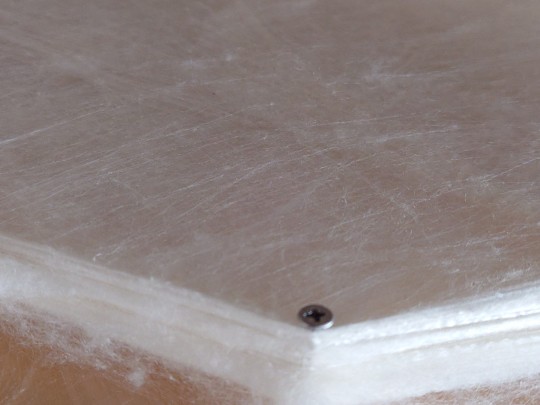
Mawata sheets
The "tsumugi" thread is made by stretching and twisting the cotton, either by pulling it out or twisting it, or neither, or both. Then, fabrics woven using the tsumugi thread is called tsumugi weaving.
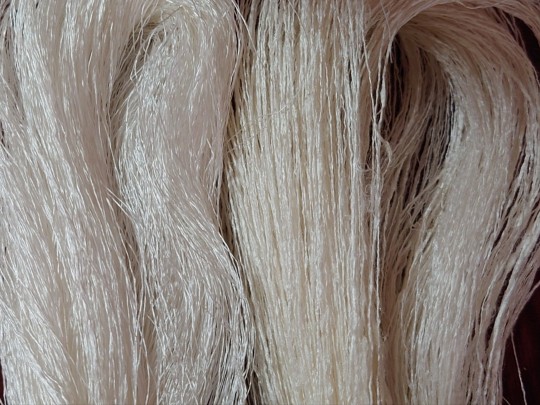
The left is raw silk and the right is tsumugi yarn spun by myself.The texture is different. Such is the case even with purchased products.
To be precise, the silkworm's thread is called "kibiso"
The silkworm's thread is made up of three parts: the beginning part, called kibiso ; the long, long raw silk part; and the end part, called "bisu".
Both kibiso and bisu have different textures from raw silk, and sometimes only these parts are collected and sold as separate yarns.
The beginning of the spit is still unstable and the end is the residue of the body, so in essence, I have heard that they are made slightly differently...In the case of the easily recognisable coloured silkworm cocoons, the hard yellow-green outer part is the kibiso,
The bis has a light yellow-green raw silk part inside, and the bis is slightly yellowish white.)
The bisu ends up looking leathery and unravelling…
Those different textures remain in the mawata, so, even if you try to stretch them out homogeneously, it is sometimes impossible to do so. That is the true nature of the knots that remain in the silk threads.
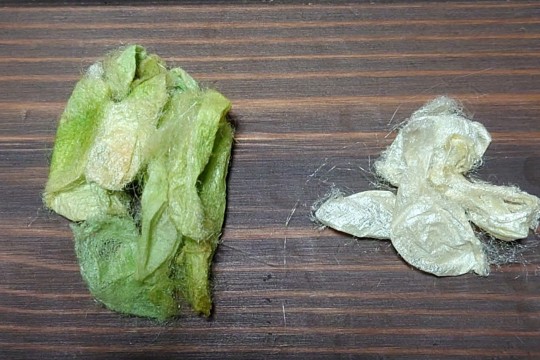
Kibiso (left) and bisu (right) of wild silkworms.(Silkworms ones do not peel so much)
In the end, what I wanted to say was that thread is a gift of life,I think it is lovely that the thread is born out of such a sense of waste.
581 notes
·
View notes
Text
Also preserved on our archive (Daily updates!)
By Stephani Sutherland
Gentle nasal spray vaccines against COVID, the flu and RSV are coming. They may work better than shots in the arm
Alyson Velasquez hates needles. She never liked getting shots as a kid, and her anxiety only grew as she got older. “It really ballooned in my teens and early 20s,” she says. “It became a full-blown phobia.” She would panic at the sight of a needle being brought into an exam room; more than once she passed out. Velasquez says that she took an antianxiety medication before one appointment yet still ran around the room screaming inconsolably “like I was a small child; I was 22.” After that episode Velasquez, now a 34-year-old financial planner in southern California, quit needles completely. “No vaccinations, no bloodwork. For all of my 20s it was a no-go for me,” she says.
Then COVID showed up. “It finally hit a point where it wasn’t just about me,” Velasquez says. “It felt so selfish not to do this for the greater public health and the safety of our global community.” So she got vaccinated against the SARS-CoV-2 virus in 2021, although she had to sit on her husband’s lap while he held her arms. “It was a spectacle. The poor guy at CVS ... he did ask me, ‘Are you sure you want to do this?’” She very much did. “I’m very pro-vaccine. I am a rational human. I understand the necessity of [getting] them,” she insists. But today she still struggles with each injection.
Those struggles would end, however, if all her future vaccinations could be delivered by a nasal spray. “Oh, my God, amazing!” Velasquez says.
The amazing appears to be well on its way. Vaccines delivered through the nose are now being tested for several diseases. In the U.S., early clinical trials are showing success. Two of these vaccines have generated multiple immune system responses against the COVID-causing virus in people who received them through a puff up the nose; earlier this year their makers received nearly $20 million from Project NextGen, the Biden-Harris administration’s COVID medical initiative. Researchers are optimistic that a nasal spray delivering a COVID vaccine could be ready for the U.S. as soon as 2027. Although recent efforts have focused on inoculations against SARS-CoV-2, nasal vaccines could also protect us against the flu, respiratory syncytial virus (RSV), and more.
A few nasal vaccines have been introduced in the past, but they’ve been beset by problems. The flu inoculation FluMist has not gained popularity because of debates about its effectiveness, and a different vaccine was pulled from the market decades ago because some people had serious side effects. In China and India, nasal vaccines for COVID have been approved because those countries prioritized their development during the pandemic, whereas the U.S. and other wealthy nations opted to stick with arm injections. But this new crop of vaccines takes advantage of technology that produces stronger immune responses and is safer than preparations used in the past.
In fact, immunologists say these spritzes up the nose—or inhaled puffs through the mouth—can provide faster, stronger protection against respiratory viruses than a shot in the arm. That is because the new vaccines activate a branch of the immune system that has evolved for robust, rapid responses against airborne germs. “It may be more likely to really prevent infection from getting established,” says Fiona Smaill, an infectious disease researcher at McMaster University in Ontario. Such inoculations may also help reduce the enormous inequities in vaccine access revealed by the pandemic. These formulations should be cheaper and easier to transport to poor regions than current shots.
But nasal vaccines still face technical hurdles, such as how best to deliver them into the body. And unlike injected vaccines, which scientists can measure immune responses to with blood tests alone, testing for immunity that starts in nose cells is more challenging. But researchers working in this field agree that despite the hurdles, nasal formulations are the next step in vaccine evolution.
Traditional vaccines injected through the skin and into an arm muscle provide excellent protection against viruses. They coax immune cells into making widely circulated antibodies—special proteins that recognize specific structural features on viruses or other invading pathogens, glom on to them and mark them for destruction. Other immune cells retain a “memory” of that pathogen for future encounters.
Intramuscular injection vaccines are good at preventing a disease from spreading, but they do not stop the initial infection. A nasal spray does a much better job. That’s because sprays are aimed directly at the spot where many viruses first enter the body: the nose and the tissue that lines it, called the mucosa.
Mucosa makes up much of our bodies’ internal surfaces, stretching from the nose, mouth and throat down the respiratory tract to the lungs, through the gastrointestinal tract to the anus, and into the urogenital tract. Mucosa is where our bodies encounter the vast majority of pathogenic threats, Smaill says, be it flu, COVID, or bacterial infections that attack the gut. This tough, triple-layered tissue is specialized to fight off invaders with its thick coating of secretory goo—mucus—and with a cadre of resident immune cells waiting to attack. “Mucosa is really the first line of defense against any infection we’re exposed to,” Smaill says.
Mucosal immunity not only prepares the immune system for the fight where it occurs but also offers three different types of protection—at least one more than a shot does. Nasal vaccines and shots both mobilize immune messenger cells, which gather the interlopers’ proteins and display them on their surfaces. These cells head to the lymph nodes, where they show off their captured prize to B and T cells, which are members of another part of the immune system called the adaptive arm. B cells, in turn, produce antibodies, molecules that home in on the foreign proteins and flag their owners—the invading microbes—for destruction. Killer T cells directly attack infected cells, eliminating them and the microbes inside. This provides broad protection, but it takes time, during which the virus continues to replicate and spread.
That’s why a second type of protection, offered only by the mucosal tissue, is so important. The mucosa holds cells of the innate immune system, which are the body’s “first responders.” Some of these cells, called macrophages, recognize invasive microbes as foreign and swallow them up. They also trigger inflammation—an alarm sounded to recruit more immune cells.
Another part of this localized response is called tissue-resident immunity. These cells don’t have to detect telltale signs of a pathogen and make a long journey to the infected tissue. They are more like a Special Forces unit dropped behind enemy lines where a skirmish is occurring rather than waiting for the proverbial cavalry to arrive. This localized reaction can be quite potent. Its activation is notoriously difficult to demonstrate, however, so historically it’s been hard for vaccine makers to show they’ve hit the mark. But it turns out that one type of antibody, called IgA, is a good indicator of mucosal immunity because IgAs tend to predominate in the mucosa rather than other parts of the body. In an early trial of CoviLiv, a nasal COVID vaccine produced by Codagenix, about half of participants had detectable IgA responses within several weeks after receiving two doses. That trial also showed the vaccine was safe and led to NextGen funding for a larger trial of the vaccine’s efficacy.
It’s possible an inhaled vaccine may provide yet one more layer of protection, called trained innate immunity. This reaction is a bit of a mystery: although immunologists know it exists and appears also to be produced by intramuscular injections, they can’t quite explain how it works. Immune cells associated with trained innate immunity seem to have memorylike responses, reacting quickly against subsequent infections. They also have been found to respond against pathogens entirely unrelated to the intended vaccine target. Smaill and her colleagues found that when they immunized mice with an inhaled tuberculosis vaccine and then challenged them with pneumococcal bacteria, the mice were protected. In children, there is some evidence that a tuberculosis vaccine, in the arm, generates this type of broad response against other diseases.
Akiko Iwasaki, an immunologist at Yale University who is working to develop a nasal vaccination for COVID, sees two major potential benefits to nasal immunity in addition to better, faster, more localized protection. First, attacking the virus in the nose could prevent the disease from being transmitted to others by reducing the amount of virus that people breathe out. And second, Iwasaki says, the spray may limit how deeply the infection moves into the body, so “we believe that it will also prevent long COVID.” That debilitating postinfection condition, sometimes marked by signs of entrenched viral particles, disables people with extreme fatigue, chronic pain, a variety of cognitive difficulties, and other symptoms.
Making a new vaccine is hard, regardless of how you administer it. It needs to raise an immune response that’s strong enough to protect against future invasions but not so strong that the components of that response—such as inflammation and fever—harm the host.
The lining of the nose puts up its own barriers—literal, physical ones. Because the nasal mucosa is exposed to so many irritants from the air, ranging from pet hair to pollen, the nose has multiple lines of defense against invading pathogens. Nostril hair, mucus, and features called cilia that sweep the nasal surface all aim to trap small foreign objects before they can get deeper into the body—and that includes tiny droplets of vaccine.
And lots of small foreign particles—often harmless—still make it through those defenses. So the nose has developed a way to become less reactive to harmless objects. This dampened reactivity is called immunological tolerance, and it may be the biggest hurdle to successful development of a nasal vaccine. When foreign particles show up in the bloodstream, a space that is ostensibly sterile, immune cells immediately recognize them as invaders. But mucosal surfaces are constantly bombarded by both pathogens and harmless materials. The immune system uses tolerance—a complex series of decisions carried out by specialized cells—to determine whether a substance is harmful. “This is very important because we can’t have our lungs or gastrointestinal tract always responding to nonharmful foreign entities that they encounter,” says Yale infectious disease researcher Benjamin Goldman-Israelow. For example, inflammation in the lungs would make it hard to breathe; in the gut, it would prevent the absorption of water and nutrients.

These barriers may hamper the effectiveness of a nasal flu vaccine that’s been around for a while, called FluMist in the U.S. and Fluenz in Europe. The inoculation is safe, says infectious disease scientist Michael Diamond of Washington University in St. Louis, but it faces a similar problem as do injected flu vaccines: it isn’t very effective at warding off new seasonal flu strains. This might be because flu strains are so common, and people are frequently infected by the time they are adults. Their immune systems are already primed to recognize and destroy familiar flu particles. FluMist is built from a live flu virus, so immune cells probably treat the vaccine as an invader and demolish it as soon as it shows up in the nose, before it has a chance to do any good. This preexisting immunity isn’t such an issue in children, who are less likely to have had multiple flu infections. Nasal flu vaccines are routinely used to inoculate kids in Europe.
In other vaccines, researchers often use adjuvants, special agents that attract the attention of immune cells, to boost a response. Some nasal vaccines use adjuvants to overcome tolerance, but in the nose, adjuvants can pose unique dangers. In at least one case, a nasal adjuvant led to disastrous consequences. An intranasal vaccine for influenza, licensed in Switzerland for the 2000–2001 season, used a toxin isolated from Escherichia coli bacteria as an adjuvant to provoke a reaction to the inactivated virus. No serious side effects were reported during the trial period, but once the vaccine was released, Swiss officials saw a concerning uptick in cases of Bell’s palsy, a disease that causes weakness or paralysis of the facial muscles, often leading to a drooping or disfigured face. Researchers at the University of Zurich estimated that the adjuvanted flu vaccine had increased the risk of contracting Bell’s palsy by about 20 times, and the vaccine was discontinued. “We need to be cautious about using adjuvants like that from known pathogens,” says pharmaceutical formulations scientist Vicky Kett of Queen’s University Belfast in Northern Ireland.
To get around the challenges posed by the nose, some researchers are exploring vaccines inhaled through the mouth. Smaill is working on one of them. She and her McMaster colleagues aerosolized their vaccine for COVID into a fine mist delivered by a nebulizer, from which it rapidly reaches the lungs. Experiments in mice have shown promising results, with mucosal immunity established after administration of the vaccine.
Another vaccine strategy is to use a harmless virus to carry viral genes or proteins. Researchers at the Icahn School of Medicine at Mount Sinai in New York City selected a bird pathogen, Newcastle disease virus (NDV). “It’s naturally a respiratory pathogen,” so it infects nasal cells, says Michael Egan, CEO and chief scientific officer of CastleVax, a company that formed to develop the NDV vaccine for COVID. A small early clinical trial showed the CastleVax vaccine was safe and caused robust immune responses in people. “Those results were very promising,” Egan says. People who received the vaccine also produced antibodies that indicated multitiered mucosal immunity, not simply the adaptive immunity from a shot in the arm.
Following that trial, the CastleVax project received NextGen funding, and results from a trial of 10,000 people are expected in 2026. Half of those people will receive a messenger RNA (mRNA) injection, and half will get the new NDV nasal spray. The data should show whether the new nasal vaccine can do a better job of preventing infection than the mRNA injections. Egan has high hopes. “We’re expecting to see a lot fewer breakthrough infections in people who got the vaccine up the nose by virtue of having those mucosal immune responses,” he says.
Florian Krammer, one of the Mount Sinai researchers behind the vaccine, engineered NDV particles to display a stabilized version of the spike protein that’s so prominent in SARS-CoV-2. “You end up with a particle that’s covered with spike,” he says. Spike protein in the bloodstream can raise an immune response. But the NDV vaccine works in another way, too. The virus particle can also get into cells, where it can replicate enough times to cause virus particles to emerge from the cells, provoking another immune reaction. Before moving into human trials, however, researchers had to complete clinical trials to establish that the Newcastle virus is truly harmless because the nose is close to the central nervous system—it has neurons that connect to the olfactory bulb, which is part of the brain. Those trials confirmed that it is safe for this use.
Nasal sprays aim directly at the spot where most viruses first enter the body: the nose. This type of caution is one reason a COVID nasal vaccine approved in India hasn’t been adopted by the U.S. or other countries. The inoculation, called iNCOVACC, uses a harmless simian adenovirus to carry the spike protein into the airway. The research originated in the laboratories of Diamond and some of his colleagues at Washington University at the start of the pandemic, when they tested the formulation on rodents and nonhuman primates. “The preclinical data were outstanding,” Diamond says. Around the time he and his colleagues published initial animal results in Cell in 2020, Bharat Biotech in India licensed the idea from the university. In a 2023 phase 3 clinical trial in India, the nasal vaccine produced superior systemic immunity compared with a shot.
Diamond says American drug companies didn’t pursue this approach, because “they wanted to use known quantities,” such as the mRNA vaccines, which were already proving themselves in clinical trials in 2020. As the pandemic took hold, there was little appetite to develop nasal vaccine technology to stimulate mucosal immunity while the tried-and-true route of shots in the arm was available and working. But now, four years later, an inhaled vaccine using technology similar to iNCOVACC’s is being developed for approval in the U.S. by biotech company Ocugen. Both inhaled and nasal forms of the vaccine are set to undergo clinical trials as part of Project NextGen. These new vaccines are using classical vaccine methods based on the virus rather than using new, mRNA-based technology. The mRNA preparations were developed specifically for intramuscular injections and would have to be significantly modified.
Codagenix, which is developing CoviLiv, sidestepped the need for a new viral vector or an adjuvant by disabling a live SARS-CoV-2 virus. To make it safe, scientists engineered a version of the virus with 283 mutations, alterations to its genetic code that make it hard for the virus to replicate and harm the body. Without all these genetic changes, there would be a chance the virus could revert to a dangerous, pathogenic form. But with hundreds of key mutations, “statistically, it’s basically impossible that this will revert back to a live virus in the population,” says Johanna Kaufmann, who helped to develop the vaccine before leaving Codagenix for another company earlier this year.
Because most people on the planet have now been exposed to SARS-CoV-2—in the same way they’re regularly exposed to the flu—some nasal vaccines are being designed as boosters for a preexisting immune response that is starting to wane. For example, Yale researchers Iwasaki and Goldman-Israelow are pursuing a strategy in animals deemed “prime and spike.”
The idea is to start with a vaccine injection—the “prime” that stimulates adaptive immunity—then follow it a few weeks later with a nasal puff that “spikes” the system with more viral protein, leading to mucosal immunity. In a study published in 2022 in Science, Iwasaki and her colleagues reported that they primed rodents with the mRNA vaccine developed by Pfizer and BioNTech, the same shot so many of us have received. Two weeks later some of the mice received an intranasal puff of saline containing a fragment of the SARS-CoV-2 spike protein. Because the animals had some preexisting immunity from the shot, the researchers didn’t add any adjuvants to heighten the effects of the nasal puff. Two weeks later researchers detected stronger signs of mucosal immunity in mice that had received this treatment compared with mice that got only the shot.
“Not only can we establish tissue-resident memory T cells” to fight off the virus in the nose, Iwasaki says, but the prime-and-spike method also produces those vigorous IgA antibodies in the mucosal layer. “And that’s much more advantageous because we can prevent the virus from ever infecting the host,” she notes. The study suggests that this approach might also lessen the chances of transmitting the disease to others because of the lower overall viral load. Experiments in hamsters demonstrated that vaccinated animals shed less virus, and they were less likely to contract COVID from infected cage mates that had not been vaccinated themselves.
Although most of the new vaccine strategies are aimed at COVID, nasal vaccines for other diseases are already being planned. Kaufmann, formerly of Codagenix, says the company currently has clinical trials underway for nasal vaccines against flu and RSV. CastleVax’s Egan says “we have plans to address other pathogens” such as RSV and human metapneumovirus, another leading cause of respiratory disease in kids.
Vaccines that don’t need to be injected could clear many barriers to vaccine access worldwide. “We saw with COVID there was no vaccine equity,” Smaill says. Many people in low-income countries never received a shot; they are still going without one four years after the vaccines debuted.
In part, this inequity is a consequence of the high cost of delivering a vaccine that needs to stay frozen on a long journey from manufacturing facilities in wealthy countries. Some of the nasal sprays in development don’t need deep-cold storage, so they might be easier to store and transport. And a nasal spray or an inhaled puff would be much easier to administer than a shot. No health professional is required, so people could spray it into their noses or mouths at home.
For these reasons, needle-free delivery matters to the World Health Organization. The WHO is using the Codagenix nasal spray in its Solidarity Trial Vaccines program to improve vaccine equity. The CoviLiv spray is now in phase 3 clinical trials around the world as part of this effort. “The fact that the WHO was still interested in a primary vaccination trial in the geographies it’s passionate about—that’s indicative that there is still a gap,” Kaufmann says. CoviLiv was co-developed with the Serum Institute of India, the world’s largest maker of vaccines by dose. The partnership enabled production at the high volume required for Solidarity.
The CastleVax vaccine with the NDV vector provides another layer of equity because the facilities required to make it already exist in many low- and middle-income countries. “The cool thing is that NDV is a chicken virus, so it grows very well in embryonated eggs—that’s exactly the system used for making flu vaccines,” Krammer says. For example, for a clinical trial in Thailand, “we just shipped them the seed virus, and then they produced the vaccine and ran the clinical trials,” he says. Many countries around the world have similar facilities, so they will not need to depend on pharma companies based in richer places.
Even high-income countries face barriers to vaccination, although they may be more personal than systemic. For very many people, the needle itself is the problem. Extreme phobia such as Velasquez’s is uncommon, but many people have a general fear of needles that makes vaccinations stressful or even impossible for them. For about one in 10 people needle-related fear or pain is a barrier to vaccinations, says C. Meghan McMurtry, a psychologist at the University of Guelph in Ontario. Needle fear “is present in most young kids and in about half of adolescents. And 20 to 30 percent of adults have some level of fear.” A review of studies of children showed that “concern around pain and needle fear are barriers to vaccination in about 8 percent of the general population and about 18 percent in the vaccine-hesitant population,” McMurtry adds.
Some people are wary of injected vaccines even if they’re not afraid of needles, Kett says; they see injections as too invasive even if the needle doesn’t bother them. “We’re hopeful that something administered by the nasal route would be less likely to come across some of those issues,” Kett says.
In the U.S., however, sprays and puffs won’t be available until they are approved by the Food and Drug Administration, which requires clear evidence of disease protection. As Diamond points out, standards for such evidence are well established for injections, and vaccine makers can follow the rule book: regulations point to particular antibodies and specific ways to measure them with a simple blood test. But for nasal vaccines, Iwasaki says, “we don’t have a standard way to collect nasal mucus or measure antibody titers. All these practical issues have not been worked out.”
Iwasaki is also frustrated with a restriction by the U.S. Centers for Disease Control and Prevention that stops researchers from using existing COVID vaccines in basic research to develop new nasal sprays. The rule is a holdover from 2020, when COVID injections had just been developed and were in short supply; people had to wait to get vaccinated until they were eligible based on factors such as age and preexisting conditions. “That made sense back then, but those concerns are years old; things are different now,” Iwasaki says. “Now we have excess vaccine being thrown out, and we cannot even get access to the waste, the expired vaccine.”
Today scientists want to contrast the effectiveness of nasal formulations with injections already in use. “Those comparisons are really important for convincing the FDA that this is a worthy vaccine to pursue,” Iwasaki says. But the restriction has held up studies by her company, Xanadu, slowing down work. (The CDC did not respond to a request for comment.)
Despite the bureaucratic and scientific hurdles, the sheer number of nasal vaccines now in clinical trials encourages Iwasaki and other scientists pursuing the needle-free route. They say it seems like only a matter of time before getting vaccinated will be as simple as a spritz up the nose.
Velasquez, for one, can’t wait for that day to arrive. The circumstances that finally forced her to reckon with her fear of needles (a global pandemic, the prospect of parenthood and the numerous blood tests that accompanied her pregnancy) were so much bigger than her. If not for them, she might still be avoiding shots. “So having vaccines without needles—I would get every vaccine any doctor wanted me to get, ever. It would be a complete game changer for me.”
#vaccination#mask up#covid#pandemic#public health#wear a mask#covid 19#wear a respirator#still coviding#coronavirus#sars cov 2#get vaccinated#vaccinate your kids
43 notes
·
View notes
Note
Hi! Jumping off your previous post on keeping peafowl as pets I've been wondering - I work at a botanical garden but we have a few animals around as well, among them peafowl. They regularly sleep in high trees, like. idk. 15-30m (50-165ft?) height and you've been mentioning a height of like 8ft. So anyway I've been wondering: Do Peafowl enjoy but not need so much height? Is there a minimum height requirement at all?
The minimum height is a bit contested among keepers, but MOST people will rec at least 8 feet. This isn't for any disease/parasite/illness health reason like pen square footage (which is the square footage needed to keep grass/cover crop in a pen, so the peafowl don't kill it to the point of bare earth, which can give them a lot of health problems), but rather for feather quality. 8 feet minimum allows you to keep at least one 4-5ft tall perch in the pen, which is the height that allows the males to sit on them without his train touching the ground. This prevents the tips of his train (the frame feathers) from getting messed up, and allows them to preen from a perch instead of the ground (which is how the boys prefer, though they'll do both, you'll see them at it more often up higher).
The reason they sleep high in trees is because it keeps them away from most predators. There isn't a LOT of stuff that can and will kill a peacock in their native land, and most of it is not going to be climbing 100 feet in the air to tussle with a 10-15lb bird in the dark when it doesn't have wings, too. Even the smaller cats like civets might hesitate to get up after them. In captivity, they don't have predators in their pen (I hope), so there's no reason they NEED to be up super high. As long as they're off the ground and their trains aren't touching the ground, they're fine. They'll still work to get as high as they can (mine in the barn figured out how to get up to this little itty bitty 2x4 I screwed to the rafters for the pigeons to roost on, back in the day), and they like to be up high, but it's not something that will make them unhealthy if they don't sleep 50+ feet up.
Most folks are pretty capable of building 8-12 feet or so high (three of my pens are 8ft, the biggest is 12ft) without too much extra in cost or effort. The lumber or other materials needed to do this are readily available at big box hardware stores here, so it doesn't involve any special ordering or engineering to create pens that meet that kind of requirement safely and without tangling with their town's laws about construction of buildings. I've seen a few people who had access to construction equipment build pens out of I-beam and poles and welded wire and stuff, 30-40 feet high and massive, which was really cool, but ultimately not a MINIMUM- and it's important to recognize that all of these measurements ARE minimums- if you have the ability to build bigger/better then by all means you should go for it, but meeting the minimum still meets the needs of the birds just fine.
But since there isn't an established minimum on height (or if there is, it's outdated at 6 feet) and it's CHEAPER to build to 6ft than to 8ft, and that's what some people do- and shouldn't, because that doesn't give the birds enough room to preen and keep their feathers clean and in shape. It may not make them sick outright, but it sure as hell will lead to a ratty looking bird you won't enjoy as much.
37 notes
·
View notes
Text
Understanding the Importance of Crop Insurance
Farming in India is not just an occupation; it is a way of life for millions of small and marginal farmers. However, the unpredictable nature of agriculture—driven by erratic weather and market fluctuations — makes it one of the riskiest livelihoods. For a small farmer, a single failed crop can lead to catastrophic financial consequences, trapping them in a cycle of debt and poverty.
This is where crop insurance becomes a game-changer. Despite its affordability, many farmers fail to understand the importance of crop insurance. In this blog, we will explore the financial risks farmers face without a crop insurance and how small premium for affordable crop insurance policies like Kshema Sukriti Crop Insurance, starting at just Rs 499/acre, is vital in safeguarding their livelihood.
Risks Farmers Face Without Crop Insurance
Agriculture in India is unpredictable because of its dependence on natural phenomena like the monsoon rains. Farmers toil for months, investing their time, effort, and hard-earned money into growing crops, but without insurance, they stand exposed to a host of risks:
Financial Losses Due to Natural Calamities
India’s agriculture is highly dependent on the monsoon due to the lack of uniform irrigation facilities across the country, while extreme weather conditions like cyclones, floods, hailstorms, and unseasonal rainfall can completely destroy crops. A farmer without crop insurance bears the full financial burden of such losses, which can amount to thousands of rupees per acre. Small and marginal farmers, who already operate on razor-thin margins, often lack the resources to recover from such setbacks.
Wild Animal Attacks
In regions prone to wild animal incursions — like elephants, rabbits, wild boars, and monkeys — farmers frequently lose significant portions of their crops. Without insurance, they need to bear these losses alone.
Increased Dependency on Loans
Farmers without crop insurance to cover damages from perils, frequently rely on loans to recover from crop failures. High-interest loans from informal sources often lead to a cycle of debt, making recovery even harder.
Why Farmers Avoid Crop Insurance
Despite its numerous benefits, many farmers in India fail to understand the Importance of Crop Insurance and remain uninsured. The reasons include:
Lack of Awareness: Many farmers are unaware of crop insurance schemes or how they work.
Perceived Cost: Farmers assume that the insurance premiums are expensive, without realising how affordable they can be.
Complex Processes: Farmers often feel intimidated by the documentation and procedures involved in insurance enrollment.
These misconceptions prevent farmers from taking advantage of a safety net that can save them from financial ruin.
Read More: https://kshema.co/understanding-the-importance-of-crop-insurance/
#agri insurance#agricultural risk mitigation#animal attack#crop disease prevention#crop insurance#climate change#crop protection#agricultural risk reduction#agriculture insurance#agricultural income protection
0 notes
Text
सरसों में सिंचाई करने से पहले पढ़ ले ये जरूरी खबर, पूरे पौधे को नष्ट कर देगा ये रोग
जयपुर: राजस्थान के किसानों के लिए सरसों की फसल पर एक महत्वपूर्ण कृषि एडवाइजरी जारी की गई है। बीकानेर स्थित स्वामी केशवानंद राजस्थान कृषि विश्वविद्यालय (SKRUM) ने किसानों को सलाह दी है कि सरसों में पहली सिंचाई सावधानी से करें, वर्ना कॉलर रोट नामक खतरनाक बीमारी का खतरा बढ़ सकता है। यह बीमारी फसल को न केवल कमजोर करती है, बल्कि अगर समय रहते इसका इलाज न किया जाए, तो पूरी फसल नष्ट हो सकती है। कॉलर रोट…
#Agricultural advisory Rajasthan mustard crop#Best irrigation practices for mustard#Collar rot disease prevention mustard#How to prevent collar rot in mustard crop#Mustard crop care advice#Mustard irrigation tips Rajasthan#Strepomycin and Carbendazim solution for mustard crop
0 notes
Photo


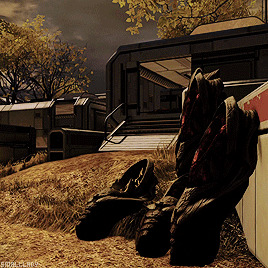



Places in Mass Effect 2 - Horizon A temperate world that has hit the "sweet spot" for carbon-based life, Horizon has a nitrogen-oxygen atmosphere maintained by abundant indigenous photosynthetic plants and bacteria. While the native plants are not very palatable to humans, the soil conditions are such that a handful of introduced Earth species have flourished, and the colonists must take strict care to prevent ecological disasters. Genetically-engineered "terminator seeds" that grow nutritious but sterile crops to minimize outbreaks are the rule rather than the exception. Animals on Horizon appear to be exploding in diversity, similar to Earth's Cambrian period. Large flying insect analogues takes advantage of the thicker-than-Earth atmosphere and low gravity to grow enormous. Microbial life have proven relatively benign; a series of vaccinations for the most virulent strains of soil-borne diseases is all that is required for a visit. Population: 654,390 Colony Founded: 2168 Capital: Discovery Orbital Distance: 2.1 AU Orbital Period: 3.0 Earth Years Radius: 5402 km Day Length: 37.8 Earth Hours Atmospheric Pressure: 1.68 Earth Atmospheres Surface Temperature: 13 Celsius Surface Gravity: 0.7 G
#mass effect#mass effect 2#smalllady gifs#meedits#gamingedit#vgedit#dailygaming#dailyvideogames#userscenery#places in mass effect
176 notes
·
View notes
Text
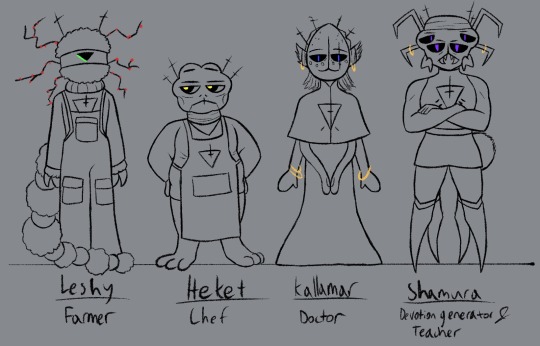
I hate drawing Shamura I HATE IT
Extras under the cut
Leshy:
He will just eat soil. He likes it, first of all, and second it actually helps him figure out soil quality
He likes how chaotically the crops are organized in the cult
But he also hates how the lamb doesn’t know anything about good farming practices
“STOP USING SHIT AS FERTILIZER”
Works with the yellow cat (Thistle)
Absolutely breaks decorations for fun
He’s in the pillory a lot because of this
Narinder is banned from the farms because leshy won’t stop trying to bite him
Kallamar is also banned because leshy doesn’t want him messing with the crops
Digs holes in the cult, then covers them up badly so people will fall in
Heket:
She’s actually really good at cooking, but she often refuses to cook well
So she’ll burn food on purpose
Steals crops from the storage chests
Literally always hungry
Conspires with leshy to steal more crops
Has trouble speaking, so she uses sign language
She also writes notes, but her handwriting is terrible
Kallamar is banned from the kitchen
Most of the cult is banned from the kitchen
Heket rules the kitchen with an iron fist
Hates the lamb SO much
Kallamar:
One of the most loyal of their siblings (desperation will do that)
Still a coward, but actually pretty chill??
“I’ve already experienced the worst death countless times, nothing could possibly be worse than that.”
Sass master
He really should not be allowed to be a doctor. He knows how to prevent diseases, yeah, but he doesn’t actually do his job
Will poison the food (which is why he’s banned from the kitchen)
Encourages the lamb to keep using shit as fertilizer
“I want to see how quickly pathogens will spread through this community”
Negative rizz, somehow gets bitches still
Actually very pathetic around his crushes
Entitled brat
MATERIAL GWORL
Shamura:
The most loyal aside from Narinder
Mostly because they’ve accepted their fate
*slaps top of their head* this spider can fit so much regret in them
Likes to spend time with kids
Very confused most of the time
On bad days, they call children by their siblings’ names
On REALLY bad days, they dissent and try to kill the lamb, thinking they’re still at war
The elders love Shamura
They miss Narinder so much
They still get prophecies, but they’re impossible to decipher now
Unless ;)
#cult of the lamb#cotl shamura#cotl kallamar#cotl leshy#cotl heket#Shen’s headcanons#Shen’s art#torn tapestries au
84 notes
·
View notes
Text
6th video in our month of plants serie!!!
And this one is of a plant we both love (those little pompoms)
We're two sisters collaborating on this video serie
@cybermanolol is in charge of the art and the editing 🎨 📽️ and @_chalulu_ is the one doing all the plant research and she's also the voice 📝🗣️

@_chalulu_ my sources are:
- Le régal végétal by François Couplan
@cybermanolol Getting the hang of gouache, don't you think? Loving these earthy, dull colours with the pops of bright yellow :)
Choose your harvesting location well:
Do not enter private property and never harvest in a protected area. Also avoid roadsides or polluted sites.
Be sure to correctly identify everything you pick so as not to damage a rare species or poison yourself.
When in doubt, abstain or call someone with the relevant competence.
Harvest plants sparingly, only where they are abundant and never collect too much.
Take only as needed and do not pull out the entire crops.
Wash before eating.
Carefully sort and wash the crop. Be careful, only cooking can prevent certain diseases or parasites such as echinococcosis or liver fluke.
#art#my art#gouache#mimosa#pleinairpril#art process#artoftheday#nature#illustration#drawing#らくがき#イラスト#traditional art#traditional painting#video#gouache painting#plein air
83 notes
·
View notes
Text
Gray mold and other fungi, which cause fruit to rot, lead to significant economic losses and food waste. Now, researchers report in the Journal of Agricultural and Food Chemistry that compounds from sunflower crop waste prevented rotting in blueberries. They suggest the food industry could use these natural compounds to protect against post-harvest diseases. Sunflowers are cultivated around the world for their seeds and oil, but the flower stems—known as receptacles—are generally considered to be a waste product. Noting that this crop is particularly resistant to many plant diseases, Xiao-Dong Luo, Yun Zhao and colleagues decided to investigate whether its receptacles might contain chemical constituents responsible for this protective effect. They also wanted to find out if these compounds could be used to fend off fungal plant pathogens in fruit, as a way to avoid the toxicity and resistance associated with chemical fungicides.
Continue Reading
86 notes
·
View notes